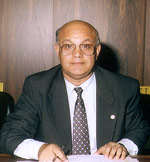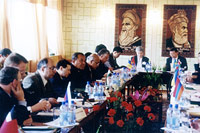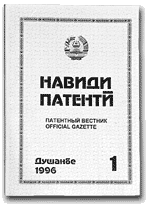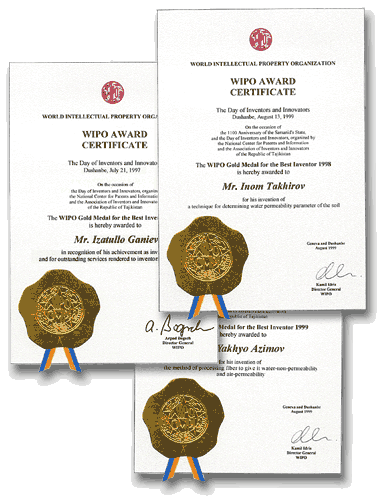|
Republic of Tajikistan 734042 Dushanbe, Ayni str. 14-a Tel.: (372) 23 35 56, 21 47 60 (reception) Fax: (372) 21 47 60, 21 71 54 e-mail: ncpi@ncpi.td.silk.org | 
|
The founding of the Republic of Tajikistan, an independent state, and the market-oriented restructuring of its economy raised the issue of creating new bodies of state government; in particular, it became essential to establish an authority for the implementation of a consistent state policy on industrial property protection.
The National Center for Patents and Information (NPICenter) was established, by Government Decree No. 242 of May 28, 1993, on the foundation laid by the Tajik Scientific Research Institute of Scientific and Technical Information and Technical and Economic Research of the Ministry of Economics and External Economic Relations of the Republic of Tajikistan. One of the main tasks delegated to NPICenter was protection of state interests with regard to inventions, industrial designs, trademarks, service marks and other industrial property objects in the Republic or abroad, as well as coordination of the work of inventors.
The NPICenter soon developed fundamental legislative documents: "The Law on Trade and Service Marks", "Temporary Provision on Inventions, Utility Models and Industrial Designs", "Statute of State Patent Fees " and other documents concerned with protection of industrial property. Over 30 provisions, instructions and rules have been developed and adopted.
The issues of titles of protection on industrial property objects and granting of Tajik Republic patents for inventions protected by author's certificates or patents of the Soviet Union have started to be addressed.
The NPICenter issues an Official trilingual (Tajik, Russian, and English) Gazette of Industrial Property "Navidi Patenti".
Fig. Front cover of the first issue of the official bulletin
NPICenter has started the development and implementation of an automated management system and compiled a database of trademarks used for examinations. The Center presently uses over 50 computers united into a local network. Scanners, laser printers and other computer equipment are available.
The Appeal Board considers complaints from both national and foreign individuals or companies, and its main objective is the protection of legal rights of applicants and owners of industrial property objects, as well as the interests of other individuals or companies in the process of considering objections.
Work toward international collaboration in the area of industrial property was started back when the national system of protection of industrial property was being formed and the legal foundation for it was in the process of being established.
In January of 1994 the Republic of Tajikistan acceded to the World Intellectual Property Organization and, according to the Government Declaration, Tajikistan considers valid on its territory important international agreements on industrial property, i.e. the citizens of the Republic may follow the procedures and norms stipulated in international agreements.
The NPICenter has participated in the development of the Eurasian Patent Convention, which the Republic of Tajikistan acceded to upon passing the Act of Accession of April 14, 1995. For our country the Convention came into force on August 12, 1995.
Following its ratification by the first three states (Turkmenistan, the Republic of Belarus, and the Republic of Tajikistan) the Convention has established an interstate system of invention protection on the basis of a common patent valid in the territories of all the Contracting states.
Participation in the Convention fully agrees with our country's external policies, and it will encourage an intensive and effective exchange of advanced scientific and technical information between countries and enhance the formation of the market of inventions in our territory.
Thus, we can confidently say that at this time the country has a functioning national system of industrial property protection; yet, many complex issues need to be resolved before the system of legal protection of industrial property becomes one of the main tools in the development of the market economy and the Republic of Tajikistan assumes a honorable place in the global system of intellectual property protection.
Tajiks are the descendants of the oldest branch of the Indo-European family of nations and one of the oldest settled societies in Central Asia; archaeological findings date at 3000 years BC or earlier.
The word "Tajik" is equivalent to "Aryan ", which means "of noble descent". In the modern Tajik language the word "Tajik" means "crowned, of noble kind". Like the name "Tajik" itself, the Tajik language has a rich and colourful history.
The modern Tajik language (Farsi) is the language also spoken in Iran and Afghanistan.
In ancient times the kingdoms of Bactria and Sogdiana were part of the Persian Empire. Bactria and Sogd gave the world its first encyclopedia of antiquity, the book of Avesta, and Zoroaster, the first prophet who spoke of but one God.
Despite the invasion that followed, the Tajiks succeeded in developing a rich culture. Spectacular palaces in the cities of Bukhara and Samarkand are a manifestation of the Tajik spirit. The Tajiks made a noticeable contribution to Farsi literature and science. It is enough to say that for five entire centuries the "Canon of Medical Science" by the genius of the Tajik people Ibn Sino (Avicenna) was the "desk book" of European physicians.
In the 9th and 10th centuries the Samanide dynasty played the central role in the consolidation of state power. The long process of the formation of one Tajik nation came to completion, with the Tajik-speaking people and their territorial formations playing the main role. The Tajik (Farsi) literary language took its final shape. During the Samanide period the conditions were right for the appearance of a whole constellation of creative personalities, e.g. Muhammad al-Khorezmi, Abu-Nasr al-Farabi, Zakariya al-Razi, Abu Ali Ibn Sino (Avicenna), Abu Reikhan al-Biruni, and the classics of world literature Abu Abdullak Rudaki and Abdulkosim Firdousi.
As the President of the Tajik Republic Emomali Rakhmonov noted in his book Tajiks in the Mirror of History, the greatness of the Tajik nation is manifested by the fact that even under the yoke of any empire or intruder the Tajiks were always able to make their language and culture dominant, and to soften the violent blows and prejudices of religious fanatics.
Tajikistan is located in the south-eastern part of Central Asia. Over 90% of its territory are mountains that are part of the Tien Shan, Gissar-Allay, and the Pamir (up to 7495 meters - the Izmail Somoni peak), with valleys (Fergana, Zeravshan, Vakhsh, Gissar valleys and others) between them.
The country has deposits of various metals and minerals, including metallic and non-metallic ores, precious and semi-precious stones, and salt. Tajikistan has deposits of rare elements, such as uranium (14% of the world's deposits), radium and others. At this time over 60 of these deposits are being developed, which constitutes 15% of known reserves. Ores of non-ferrous metals and gold are extracted and enriched.
Extensive reserves of hydroelectric energy and mineral deposits enhanced the industrialization of rural Tajikistan during the Soviet period.
The Republic holds second place in the CIS, after Russia, in hydroelectric capacity, but produces only 17-18 billion kilowatt-hours. The country has the capability to produce 100-150 billion kilowatt-hours (even up to 300 billion according to some estimates) which, if harvested, would make it the biggest producer of electric energy in Central Asia. Presently only 10% of the country's hydroelectric capacity is utilized. Most hydroelectric energy is produced by the power stations on the Vakhsh river, the biggest of which is the Nurek Hydro-Power Station(3000 Megawatts).
The availability of hydroelectricity, which constitutes 90% of energy produced in Tajikistan, allowed the development of aluminum production (Tajik Aluminum Smelter is the world's fourth largest) and other energy-intensive industries oriented towards the use of cheap energy, e.g. the electrochemical complex in Yavan which produces table salt, magnesium chloride, chlorine and other compounds from locally mined salts, dolomite and limestone.
According to the year 2000 population census, over six million people live in Tajikistan. The population is mainly concentrated in the western part of the country, as the east is occupied by the Pamir mountain range. The central area around the city of Dushanbe (about 600 thousand) is also quite populated.
About 70% of the population are rural dwellers. The average yearly population growth in the 1980's was 3%, which means that at this time half of the people are less than 20 years old.
The civil war, which started after Tajikistan acquired independence, resulted in the loss of 66 thousand lives and economic damage of $7 billion dollars US, which was equivalent to 18 years' worth of gross national product in the 1994 figures. Thus, Tajikistan's top priority is the restoration of the war-damaged economy and conducting market reforms.
1993
The formation of the National Center for Patents and Information (August 17, 1993).
1994
Accession to the World Intellectual Property Organization and becoming party to important international treaties concerned with industrial property protection.
Coming into force of the Temporary Statute of Inventions, Utility Models and Industrial Designs
1995
Signing of the Act of Accession of the Republic of Tajikistan to the Eurasian Patent Convention (April 14, 1995).
Start of granting of titles of protection on industrial property objects (April 4, 1995).
1996
The granting of the first invention patent in the Republic of Tajikistan (September 5, 1996).
The first publication of the Official quarterly Gazette Navidi patenti.
Setting up the institution of patent attorneys in the Republic of Tajikistan, and adopting the legislative base for its work.
1997
First republican conference "The National System of Industrial Property Protection in the Republic of Tajikistan" and a competition for the title of Tajikistan's Best Inventor.
Awarding the WIPO Gold Medal to the best inventor of the Republic of Tajikistan.
Regional conference "The National System of Industrial Property Protection in the Republic of Tajikistan" in the city of Khudjand.
1998
Regional conference "The National System of Industrial Property Protection in the Republic of Tajikistan" in the city of Kurgantyube.
1999
Awarding two WIPO Gold Medals to the best inventors of Tajikistan in 1998 and 1999.
Regional conference "The National System of Industrial Property Protection in the Republic of Tajikistan" in the city of Khorog
2000
The 10th meeting of the Interstate Council of CIS on the Protection of Industrial Property held in the city of Dushanbe.

|
The 9th meeting of the Administrative Council of the Eurasian Patent Organization held in the city of Dushanbe.
Development of the legislative base
According to the Constitution of the Republic of Tajikistan, current general and special legislation, and in particular the Law on Trademarks, Statute of Inventions, Utility Models and Industrial Designs, Statute of Fees, and the Statute of Registration of Appellations of Origin, NPICenter is responsible for the protection of industrial property.
Accumulated experience in the practical application of the legislation serves as the foundation for further development of the normative base in the area of industrial property protection. The drafts of the Law "On Inventions", "Statute of the Trade Names", and "Statute of Subdivisions of the Protection of the Industrial Property Objects at Enterprises" have been developed and presented to the Government for its consideration.
Development of draft laws on the protection of such industrial property objects as service inventions, secret inventions, and industrial designs is planned for the nearest future.
The National Center for Patents and Information (NPICenter), which plays the role of state patent office, is a department of the Ministry of Economy and External Economic Relations of the Republic of Tajikistan.
NPICenter acts as a state body with the authority to protect industrial property in the territory of Tajikistan according to national legislation in that area and the provisions of international conventions, agreements, and treaties to which Tajikistan is a party.
The NPICenter consists of the management personnel, state examination department, divisions of scientific and technical information, State Patent and Technical Library.
In 2000 the staff of the Center is 107 full-time employees, of which 68 are university graduates, 39 have some post-secondary education, and 8 hold doctoral or master's degrees.
Patent attorneys
The institute of patent attorneys is governed by the Statute that stipulates the procedure of certification and registration of patent attorneys.
The data is entered into the State Register of Patent Attorneys. The Republic currently has 5 certified patent attorneys.
The Appeal Board
The Appeal Board, formed in May of 1996, is a body of the National Center for Patents and Information, and its aim is to consider, within its authority, any disagreements pertaining to legal protection of industrial property.
The Appeal Board decisions are final for the purposes of state examination. At this time establishment of a special court specializing in the protection of industrial property is being considered. Presently the final decision concerning the applicant is made by the Republic's court system.
The State Patent and Technical Library (SPTL) of the National Center for Patents and Information is one of the Republic's largest libraries; it has patent, normative, and scientific information on many branches of industry.
The SPTL has over 13 million items, of which over 11 million are patent documentation, over 200 thousand are normative and technical documentation, over 280 thousand are books and periodicals on natural science, economics or technology published in the Republic or abroad, and over 390 thousand contain miscellaneous information.
Since 1986 new books, and since 1988 new articles supplied with abstracts, are entered into an electronic catalogue.
INVENTIONS: From 1993 to present the Office has received 619 applications for invention patents. 262 decisions to grant invention patents have been made. The first invention patent was granted in 1996. By the end of 1999 the number of valid patents was 211.

|
INDUSTRIAL DESIGNS AND UTILITY MODELS: From 1993 to present the Office has received 26 applications for industrial design patents and 4 applications for the registration of utility models. 18 decisions have been made to grant industrial design patents and two decisions to grant certificates for utility models.
TRADEMARKS: From 1993 to the present time the Office has received 23905 applications for the registration of trademarks, of which 5338 were to be registered in the national system and 18567 according to the Madrid Agreement.
During that period, complete examination of 4895 trademarks in the national system and 16518 trademarks in the international system were carried out. 4499 trademarks were registered, and certificates issued for 4043 of them. The Office's Official Gazette currently has information on 4244 trademarks.
In order to stimulate inventor activity and to widely disseminate information on industrial property, two republican and three regional conferences in all of the country's regions have been conducted since 1997. Guestbook entries testify to the successful of these important events. The most common theme was that the inventors feel that the society needs them and that these conferences were a confirmation of the fact that peace is being established in Tajikistan. Conferences and competitions were well covered in the press, radio and television.
The publication of conference materials and reports is the first publication of the key information on the system of industrial property protection and related concepts in Tajikistan.

In order to enhance the inventor activity and unite inventors, scientists, leading experts and creative intelligentsia, the competition for the title of Best Inventor was held in 1997. The winner was the Doctor of Chemical Sciences I.N. Ganiyev, who was the first Tajik citizen to receive the WIPO Gold Medal.
A competition for the title of Best Inventor among the owners of Tajik patents was held in 1999. The winners were awarded WIPO Gold Medals for best inventions.
Doctor of Technical Sciences I.G. Takhirov was the winner of the WIPO Gold Medal for best invention in 1998, and Candidate of Economic Sciences Ya. N. Azimov won one in 1999.
The creation of a close-knit professional team able to meet all the objectives facing the Office may be considered as the main achievement of the period.
National offices of the CIS countries (Armenia, Belarus, Georgia, Kyrgyzstan, Kazakhstan, Moldova, Russian Federation, and the Ukraine) and international organizations (the World Intellectual Property Organization, the European Patent Office and the Eurasian Patent Office) rendered great help in the formation of this team and in raising its professional level.
Yet, many complex issues need to be resolved in order for the system of legal protection of industrial property to become one of the main instruments of the development of market economy in our country, thus allowing Tajikistan to assume an honourable place in the global system of intellectual property protection.
The most important goal is the development of the system of laws and normative documents in the area of legal protection of intellectual property objects.
Starting with the development of the Eurasian Patent Convention by the interstate working group of experts in 1993 (with I.G. Takhirov representing the Republic), Tajikistan, as represented by the NPICenter, actively participated in all the events by the Interstate Council for the Protection of Industrial Property and by the Administrative Council of the Organization.
In 1996, at the fourth meeting of the Organization's Administrative Council (held in Almaty), a representative our country, Doctor of Technical Sciences Kh. F. Fayazov, was elected Vice President of the Eurasian Patent Office. At the same time the logo of the Eurasian Patent Organization, developed by an employee of the NPICenter, Candidate of Technical Sciences G. D. Koupai, was adopted after winning a competition.
In 1997 the text of the Eurasian Patent Convention was prepared in three languages - Tajik , Russian and English - and published as a book. Publication of the Eurasian Patent Convention in the language of one of the countries which ratified it is an important event contributing to the Convention's effectiveness in protecting inventions in the territory of the Tajik Republic.
Fig. Front cover of the Eurasian Patent Convention in three languages
Presently two of our examiners from the Department of State Examination of Inventions, Sh. T. Sakhibov and M.N. Yusupov, are working in the Eurasian Patent Office.
In March of 2000, the 9th meeting of the Administrative Council of the Organization, which, among other issues, considered the celebration of the 5th anniversary of the Eurasian Patent Organization, was held at the NPICenter in Dushanbe.
The participants of the meeting reviewed the activity of the National Center for Patents and Information of the Republic of Tajikistan and unanimously remarked on the high level of its work and its excellent degree of readiness for the meeting.
Holding the Administrative Council meeting in Tajikistan became yet another confirmation of the words of the Tajik president E. Rakhmonov that "No manner how complicated life is because of the military conflict pushed upon us, no matter how hard is the economic situation in the country that is struggling to get out of the depth of crisis, we keep on hoping for a better future and are resolute to win, given time, an honourable place in the world community and, by working together, enable the citizens of the Republic to live in dignity."
Director of NPICenter I.G. Takhirov